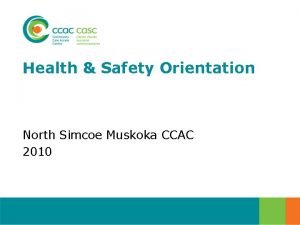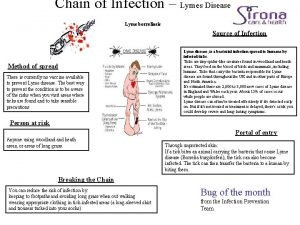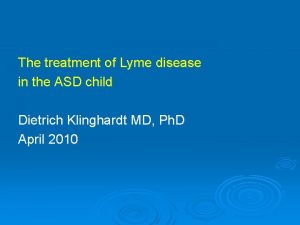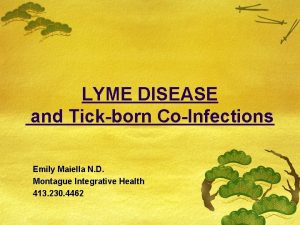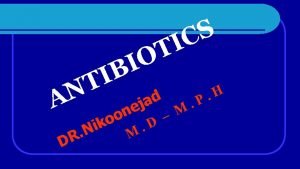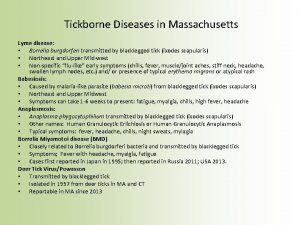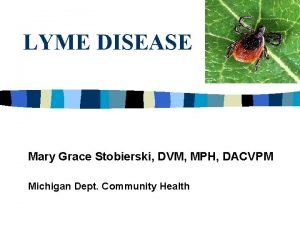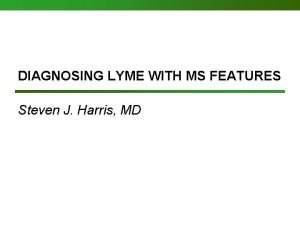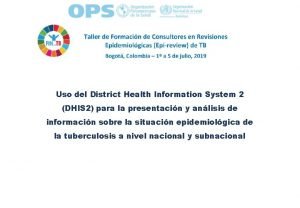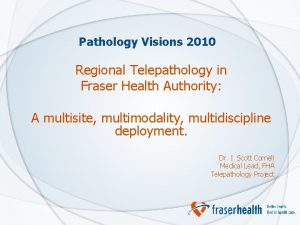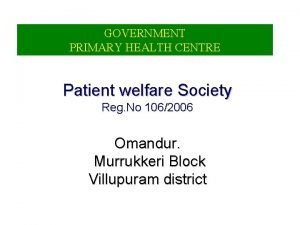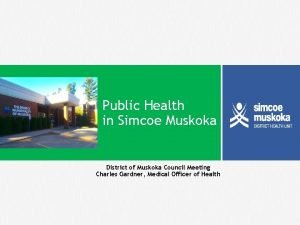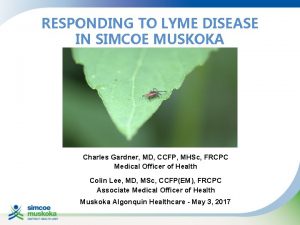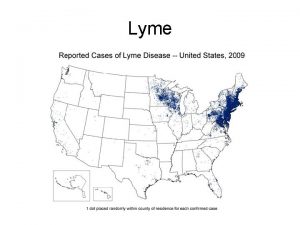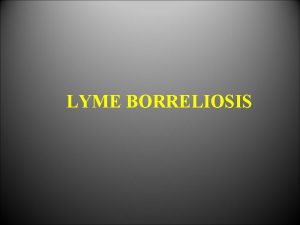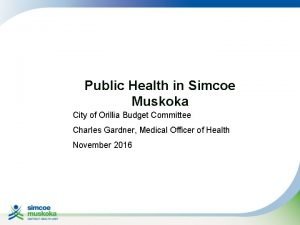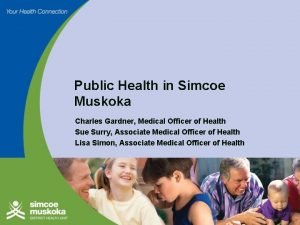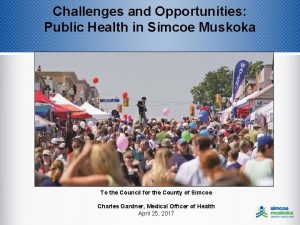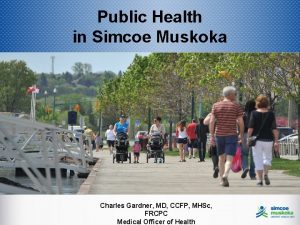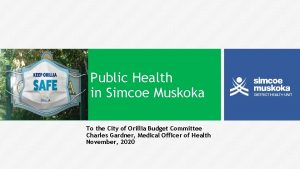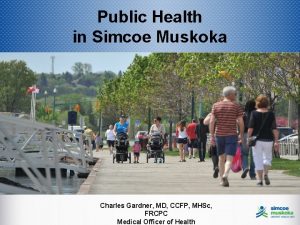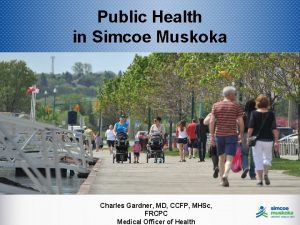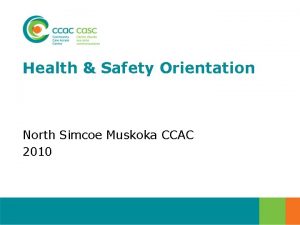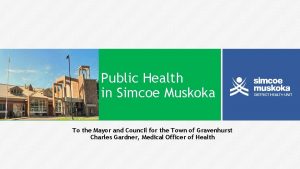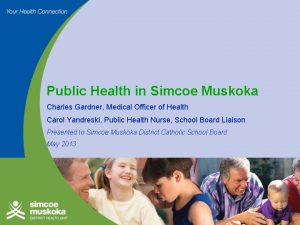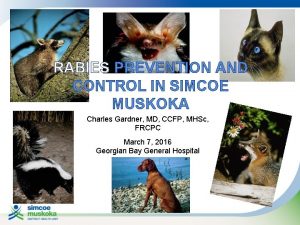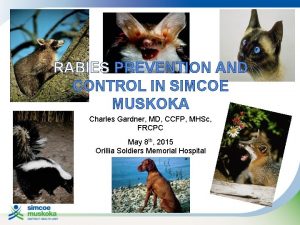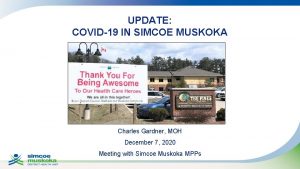Lets Target Lyme Simcoe Muskoka District Health Unit




























- Slides: 28

Let’s Target Lyme Simcoe Muskoka District Health Unit: Dr. Charles Gardner, Medical Officer of Health Lori Holmes, Healthy Environments & Vector Borne Disease Coordinator University of Toronto, Dalla Lana School of Public Health: Jean-Paul R. Soucy, Ph. D Student Barrie Canoe and Kayak Club • April 8, 2019

Let’s Target Lyme • Public Health - Our Role and Mandate • Education, monitoring, surveillance • What is Lyme? • The illness • Blacklegged Ticks, Life cycle, Seasonality • Exposure Risk? Where? • Safe removal of ticks • Surveillance • Are ticks an issue within Simcoe Muskoka? • How many cases are investigated by public health per year? • Have the numbers increased? • Protecting yourself – Simple and Easy • Repel • Inspect • Remove

Public Health: Our Role, Our Mandate Public Health’s Role • • • Conduct surveillance and assess data Provide information, increase awareness of Lyme disease and communicate risk of exposure to ticks Collaborate with key stakeholders: health care providers, municipalities, provincial and federal public health partners Surveillance activities will assist in: ü supporting better diagnosis of Lyme disease; ü assessing locations within Simcoe Muskoka as a potential risk areas; ü increase awareness of local tick populations and Lyme disease risk; ü Educating the public, at risk groups and stakeholders

Myth: I can get Lyme disease from mosquitoes or other insects.

What is Lyme disease? • A bacterial illness caused by the bacteria Borrelia burgdorferi. • In Ontario, the bacteria is transmitted by an infected Ixodes scapularis (blacklegged) tick • Most common disease spread by ticks in Canada. • Symptoms can vary from person to person. • Diagnosis and appropriate treatment can be challenging to provide.

When a tick is missed… • Early localized: – fever, headache, muscle/joint pain, fatigue and erythema migrans (EM) – Incubation period of EM usually 7 -10 after tick exposure • Late disease: – cardiac arrhythmias, recurrent arthritis of large joints, peripheral neuropathy, CNS manifestations • Early disseminated disease: – ongoing EM, cranial nerve palsies, meningitis, conjunctivitis, arthralgia, extreme fatigue, carditis Source: CDC, 2016 (www. cdc. gov/lyme/signs_symptoms) Symptoms can be seen any where from 3 – 30 days following a tick bite.

Myth: Ticks are large enough to see with the naked eye.

How “Big” are ticks? • Ticks are small and can be difficult to see (especially larvae & nymphs). • Part of the arachnid family and considered an ectoparasite. Photo Credit: Patrick Mansell via https: //news. psu. edu/photo/524732/2018/06/11/ticksvandegrift-10011

Life Cycle Year 1 Larvae Greatest risk of human infection late spring & summer. Eggs Nymphs Life Cycle Credit: Ontario Agency for Health Protection and Promotion (Public Health Ontario). Blacklegged tick life cycle. Toronto, ON: Queen’s Printer for Ontario; 2016. Adults Year 2

Exposure risk? • • Tick Habitat: Deciduous, mixed forest, brushy areas providing food and protective cover. – Exposure to ticks can be greatest in tall grassy areas, along hiking/walking trails and edges of woods. Individuals who participate in outdoor activities can be at risk: – Outdoor enthusiasts • Sporting Activities, Hunting & Fishing, Camping, Portaging, Gardening, Hiking – Outdoor workers • Landscapers • Parks and Rec Employees Photo Credits: Barrie Canoe and Kayak Club, 2018

Ticks are outdoors – so what? Benefits of Outdoor Activity • Hiking is… – An excellent form of exercise. – A way to connect with nature. – An activity that forms social bonds. Hiking protects against heart disease, diabetes, cancer, and many other diseases. CC BY-SA 3. 0 Tommy 2010

Myth: Ticks can be removed with petroleum jelly, baby oil or your fingers.

Proper technique for removing a tick • Fine tipped tweezers are best • Pull up, even pressure – do not twist or squeeze • Clean area thoroughly • Submit the tick for identification • Follow up with your health care provider Source: US Centers for Disease Control Do not: • Use your fingers to remove a tick • Squeeze or crush the tick’s body • Paint, burn or apply petroleum jelly to the tick

Myth: Lyme disease bacteria can be transmitted in as little as two hours.

Probability of Transmission Tick bites are usually painless. Not all blacklegged ticks are infected. Source: CDC - Sood SK et al 1997, JID; Nadelman RB et al 2001 NEJM

When to seek medical attention? • Presence of signs and symptoms – Are you feeling unwell after you were bitten by a tick attached for >24 -48 hrs? – If you have a bulls-eye rash, is it getting larger? • You have received a tick bite while in an area where the presence of blacklegged ticks has been identified (PHO Risk Map) • If you are unable to remove the tick • As soon as reasonably possible Early detection of ticks is essential to reduce your risk of being exposed to Lyme disease bacteria.

HUMAN LYME DISEASE CASES: REPORTED EXPOSURE LOCATIONS

Incidence of Lyme Disease: Simcoe Muskoka and Ontario Lyme disease rates by PHU for all ages, sexes, ON, 2017 Source: Public Health Ontario, 2019 https: //www. publichealthontario. ca/en/da ta-and-analysis/infectiousdisease/reportable-disease-trendsannually#/34

Myth: Blacklegged ticks are not prevalent in Simcoe – Muskoka.

Where do we receive ticks from? • Data has shown us that blacklegged ticks are present and establishing in Simcoe Muskoka. • Tick submissions are a valuable source of data to inform us of potential areas where active surveillance (tick dragging) is warranted • Examples of species commonly identified: – I. scapularis (BLT) – D. variabilis (American Dog Tick) – I. cookei (Groundhog Tick) • Tick submissions and subsequent results are not a tool to inform diagnostic testing

Passive Surveillance Tick Submissions • How to submit: ü Place tick in a sterile container with tight fitting lid ü Complete the “Surveillance Form for Tick Identification” ü Bring the tick into one of SMDHU’s offices (preferred method); or submit via your health care provider. Only ticks removed from a person can be submitted to public health for identification.

South Simcoe

Active Surveillance Tick Dragging • Assists in the determination of provincial ‘risk’ areas • Identify established tick populations – ‘Risk Area’: where at least one BLT is collected during spring AND fall sampling events (late Spring and Fall) • Track the expansion of BLTs and the prevalence of Borrelia Burgdorferi provincially and locally

2015 This document was adapted with the permission of Public Health Ontario assumes no responsibility for the content of any publication resulting from translation/ changes/ adaptation of PHO documents by third parties.

This document was adapted with the permission of Public Health Ontario assumes no responsibility for the content of any publication resulting from translation/ changes/ adaptation of PHO documents by third parties.

Avoid • Repel • Inspect • Remove • Ticks like long grasses and tops of shrubs, wooded bushy areas and the leaf litter areas of forests. • Wear a repellant containing DEET or Icaridin • Dress appropriately. • Stay on the middle of hiking trails. • Preform “tick checks” on yourself, family members and pets. • Take a shower within two hours. Source: https: //www. cdc. gov/lyme/prev/on_p eople. html Photo Credit: http: //www. michigan. gov/emergingdis eases/0, 4579, 7 -186 -25890 -76350 -, 00. html • Around your home: • Keep your yard trimmed, remove piles of leaves, sticks • Move woodpiles and bird feeders away from the house

As an outdoor organization we can… • Provide education and awareness about Lyme disease prevention • Conduct trail maintenance • Leadership by hike leaders Image Credit: Barrie Canoe and Kayak Club, 2018

Take Away Messages. . . • Avoid, repel, inspect & remove • Tick bite? You have time to seek medical attention. • Blacklegged ticks are present throughout Simcoe County and District of Muskoka* • Lyme disease is preventable.
 North simcoe muskoka ccac
North simcoe muskoka ccac Met office inshore
Met office inshore Chain of infection for lyme disease
Chain of infection for lyme disease Sarsaparilla lyme
Sarsaparilla lyme Ttanos
Ttanos Rizol zeta drops
Rizol zeta drops Point o woods old lyme ct
Point o woods old lyme ct Spray tanning lyme regis
Spray tanning lyme regis Dr jack lambert lyme disease
Dr jack lambert lyme disease Azlocillin lyme disease
Azlocillin lyme disease Borrelia burgdorferi cdc
Borrelia burgdorferi cdc Lyme disease
Lyme disease Criterios light
Criterios light Dr steven harris lyme
Dr steven harris lyme Primary target market and secondary target market
Primary target market and secondary target market Unit 6 review questions
Unit 6 review questions Dhmsi
Dhmsi District integrated health and family welfare society
District integrated health and family welfare society District health information system
District health information system District health action plan
District health action plan Fraser health regions map
Fraser health regions map District health office
District health office Villupuram district primary health centre
Villupuram district primary health centre North central district health department ct
North central district health department ct Benzie leelanau health department
Benzie leelanau health department Bbc bitesize tissue poem
Bbc bitesize tissue poem Lets get a lock for this thing cartoon
Lets get a lock for this thing cartoon Lets copy saldanha
Lets copy saldanha Lets think english
Lets think english
